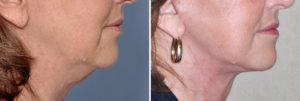A facelift is one of the most recognized procedures in aesthetic plastic surgery…..but also one of the most misunderstood. The general public’s perception of a facelift….based on TV shows and the internet…is someone after such surgery being bruised from their eyes to their neck and their face wrapped up in a big dressing…like they had been involved in a major accident. And that it will take weeks to even look good enough to go out in public. In reality, this perception is flawed at best and even grossly inaccurate at worst.

Therefore, when you realize that only the neck and jowl are affected by the procedure, many of its misconceptions fade away. In isolation as a stand-alone procedure (which half of my ‘facelift’ patients only have), a facelift causes no bruising or swelling from the nose up. While many facelift patients get their eyes, forehead, nose and other facial procedures done at the same time, this is not a requirement and is only done if one wants the ‘total face’ rejuvenated. I find that after an isolated facelift, one can look pretty good in about a week and can easily be out in public in a few days with a little make-up in the neck area.
Remember, the eyes are not swollen at all!
One of the great misconceptions about a facelift is what is actually done in the operation. A facelift operation is all about tissue layers and vectors of lifting. The lifting off of the skin from the underlying tissues over the side of the face (to the cheek area) and across the neck through incisions placed in and around the ears is obvious in any diagram of a facelift operation. And movement of loose skin pulled back and over the ears at about a 45 degree angle to the face probably accounts for about 80% – 90% of the result created by a facelift. And often this is the only tissue moved in a facelift. This is the safest and easiest approach with the least likelihood of complications.
Deeper layers have also been raised up and moved in more recent versions of facelift surgery. These deep layer that can be moved independent of the skin, is a special layer of tissue over the muscle. This tissue, known as SMAS, is raised and sutured up in a more vertical direction compared to the direction of the skin pull, closer to 60 degrees usually. The public erroneously believes that it is muscle that is moved which is not possible. The SMAS sits on top of the muscle. There is considerable debate as to whether the ‘deeper’ versions of the facelift produce better long-term results than skin movement only.
The neck-jowl lift, known historically as a facelift, can lift two different layers of sagging facial tissues in two slightly different up and backward directions.
Dr Barry Eppley
Indianapolis, Indiana


